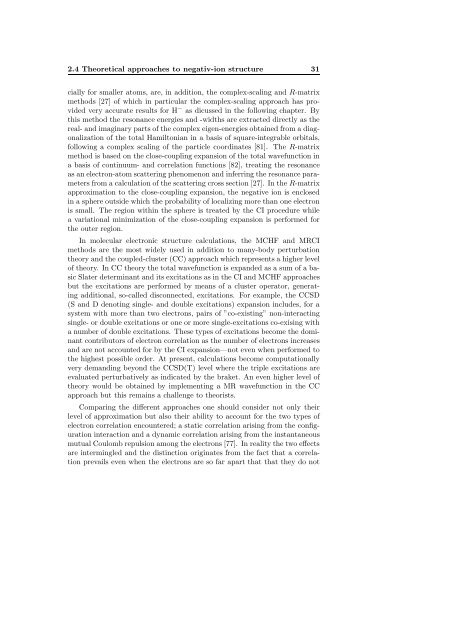VUV Spectroscopy of Atoms, Molecules and Surfaces
VUV Spectroscopy of Atoms, Molecules and Surfaces
VUV Spectroscopy of Atoms, Molecules and Surfaces
Create successful ePaper yourself
Turn your PDF publications into a flip-book with our unique Google optimized e-Paper software.
2.4 Theoretical approaches to negativ-ion structure 31<br />
cially for smaller atoms, are, in addition, the complex-scaling <strong>and</strong> R-matrix<br />
methods [27] <strong>of</strong> which in particular the complex-scaling approach has provided<br />
very accurate results for H− as dicussed in the following chapter. By<br />
this method the resonance energies <strong>and</strong> -widths are extracted directly as the<br />
real- <strong>and</strong> imaginary parts <strong>of</strong> the complex eigen-energies obtained from a diagonalization<br />
<strong>of</strong> the total Hamiltonian in a basis <strong>of</strong> square-integrable orbitals,<br />
following a complex scaling <strong>of</strong> the particle coordinates [81]. The R-matrix<br />
method is based on the close-coupling expansion <strong>of</strong> the total wavefunction in<br />
a basis <strong>of</strong> continuum- <strong>and</strong> correlation functions [82], treating the resonance<br />
as an electron-atom scattering phenomenon <strong>and</strong> inferring the resonance parameters<br />
from a calculation <strong>of</strong> the scattering cross section [27]. In the R-matrix<br />
approximation to the close-coupling expansion, the negative ion is enclosed<br />
in a sphere outside which the probability <strong>of</strong> localizing more than one electron<br />
is small. The region within the sphere is treated by the CI procedure while<br />
a variational minimization <strong>of</strong> the close-coupling expansion is performed for<br />
the outer region.<br />
In molecular electronic structure calculations, the MCHF <strong>and</strong> MRCI<br />
methods are the most widely used in addition to many-body perturbation<br />
theory <strong>and</strong> the coupled-cluster (CC) approach which represents a higher level<br />
<strong>of</strong> theory. In CC theory the total wavefunction is exp<strong>and</strong>ed as a sum <strong>of</strong> a basic<br />
Slater determinant <strong>and</strong> its excitations as in the CI <strong>and</strong> MCHF approaches<br />
but the excitations are performed by means <strong>of</strong> a cluster operator, generating<br />
additional, so-called disconnected, excitations. For example, the CCSD<br />
(S <strong>and</strong> D denoting single- <strong>and</strong> double excitations) expansion includes, for a<br />
system with more than two electrons, pairs <strong>of</strong> ”co-existing” non-interacting<br />
single- or double excitations or one or more single-excitations co-exising with<br />
a number <strong>of</strong> double excitations. These types <strong>of</strong> excitations become the dominant<br />
contributors <strong>of</strong> electron correlation as the number <strong>of</strong> electrons increases<br />
<strong>and</strong> are not accounted for by the CI expansion—not even when performed to<br />
the highest possible order. At present, calculations become computationally<br />
very dem<strong>and</strong>ing beyond the CCSD(T) level where the triple excitations are<br />
evaluated perturbatively as indicated by the braket. An even higher level <strong>of</strong><br />
theory would be obtained by implementing a MR wavefunction in the CC<br />
approach but this remains a challenge to theorists.<br />
Comparing the different approaches one should consider not only their<br />
level <strong>of</strong> approximation but also their ability to account for the two types <strong>of</strong><br />
electron correlation encountered; a static correlation arising from the configuration<br />
interaction <strong>and</strong> a dynamic correlation arising from the instantaneous<br />
mutual Coulomb repulsion among the electrons [77]. In reality the two effects<br />
are intermingled <strong>and</strong> the distinction originates from the fact that a correlation<br />
prevails even when the electrons are so far apart that that they do not















